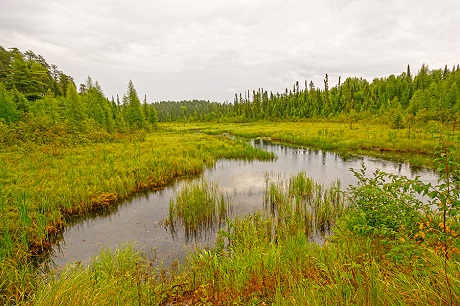Conserving Biodiversity
Canfor has detailed Sustainable Forest Management Plans for each of its operations. They include plans, measures and activities that conserve and protect areas with high conservation values such as riparian (streamside or lakeshore) areas and old growth forests.
These plans outline our strategies for managing biodiversity at species, stand and landscape levels. Examples include strategies for coarse woody retention, riparian reserves, rare ecosystems, and species at risk. A comprehensive species accounting system has been developed for our BC operations by independent scientists so we can monitor key species groups and take action if negative impacts appear to be occurring. This system is being implemented in various stages, with our operations in the Chetwynd and East Kootenay regions taking the lead.
We update our management plans to incorporate new information, such as changes to higher-level plans that specify biodiversity targets or objectives to improve biodiversity and maintain ecosystem function and resilience through the retention or distribution of residual trees. We prioritize retention in areas with the greatest diversity and unique features such as internal decay or loose bark suitable for bat habitat. We also consider climate change in our management of forest ecosystems resilience.
In the Morice Land and Resource Plan Area in northwest BC, our Houston planning staff have been collaborating with government and industry partners to develop workable land use orders to conserve biological diversity while balancing the local community’s socio-economic interests. The BC government established legal objectives in September 2016 for special areas, including those with high biodiversity emphasis, wildlife tree retention, high First Nations values and old growth management. We are working to incorporate these objectives into our operational plans, and will incorporate results and strategies into our forest stewardship plan.
Ducks Unlimited Canada (DUC) and a number of forest sectors leaders, including Canfor, have agreed to share knowledge and resources to advance sustainable forestry management and wetland stewardship in Canada’s boreal forest. Through the three-year Forest Management and Wetland Stewardship Initiative, the partners will work collaboratively to integrate wetland and waterfowl conservation into ongoing forest management planning and field operations. They will also establish wetland conservation guiding principles and best management practices.

Canfor is partnering with Ducks Unlimited Canada and other forest sector leaders to advance sustainable forest management and wetland stewardship in Canada’s boreal forest.
In 2016, we led the development of a migratory bird management tool -- in partnership with other licensees -- that is designed to help protect populations of migratory birds in BC’s interior. It was highlighted as a good practice by the teams that audited our operations for SFI and CSA certification. The tool uses forest inventory variables to predict the relative density of migratory bird nests in a forest stand. It then maps it as a GIS layer so users can apply best management practices to reduce the risk of incidental take in the higher-ranked stands. We expect full implementation in 2018. Our senior forest scientist is working with the Canadian Wildlife Service and University of Alberta to test the risk matrix with bird data collected in BC.
In a unit in the McGregor Valley northeast of Prince George, we have taken the lead on an old growth forest recruitment strategy that involves spatial identification of areas that will be retained for old forest values so we can better manage stands infested by the spruce beetle. In the absence of spatial retention, harvesting would not be permitted in the unit for many years. The areas include old forest and younger stands, and were designed with input from biologists, guides and trappers, recreationists, other forest professionals and government representatives. We will submit a plan to government for approval in 2017.
Since 2013, our Alberta operations have been part of the Healthy Landscapes Program, a collaborative program created by fRI Research to help understand how human disturbances like cutblocks can be designed to more closely resemble natural disturbances such as wildfire. The aim is to create and maintain healthy forests that support the diversity of species that rely on them. The program has created an interactive website, Lessons from Nature, designed to let viewers explore important topics, including a series of images illustrating applications of the healthy landscapes approach.
As part of our FSC certification, Canfor’s East Kootenay operations worked with environmental groups, government and wildlife experts to update their High Conservation Value (HCV) areas. These were first identified 10 years ago, and have been refined to incorporate new scientific knowledge and new information on locations of species at risk. HCV areas have special forestry management strategies developed to maintain or enhance the values within them.
We also partnered with Wildsight, a local environmental society, to conduct post-harvest effectiveness monitoring in cutblocks within these HCV areas. The monitoring results for 2015 showed that 100% of wildlife tree patches checked in the field had value for wildlife, protection of high value snags identified pre-harvest was good, and that most riparian reserves were designed based on ecological features such as topography and stand boundaries. Areas where monitoring results suggested we could improve our practices included designing reserve patches to better withstand blowdown and ribboning around wet areas. This monitoring program will continue in 2017 and will include Lands and Resource Stewardship Assistants from the Ktunaxa Nation.
In Alberta, Canfor has elected to use the Foothills Research Institute’s stream crossing program, which aims to monitor and improve stream crossings, implement new ideas, and improve the environmental record of participating companies like Canfor. We expect to have inspected all 232 inventoried stream crossings in the next five years.